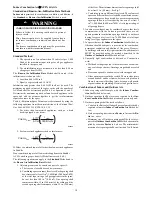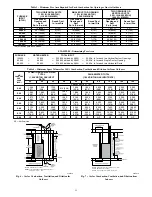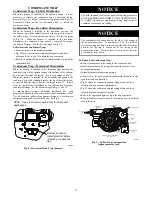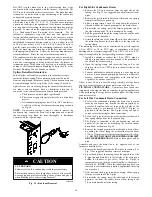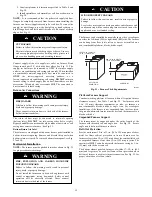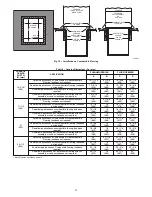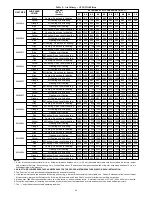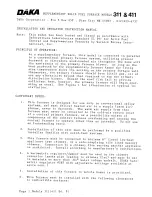
22
Bottom Return Air Inlet
These furnaces are shipped with bottom closure panel installed in
bottom return--air opening. Remove and discard this panel when
bottom return air is used. To remove bottom closure panel, see Fig.
27 and 28.
Side Return Air Inlet
These furnaces are shipped with bottom closure panel installed in
bottom return--air opening. This panel MUST be in place when
side return air inlet(s) are used without a bottom return air inlet.
Not all horizontal furnaces are approved for side return air
connections See Fig. 24. Where required by code, seal bottom
closure to furnace with tape, mastic, or other durable sealing
method.
1 Lay furnace on the back or side
2 Remove the two (2) screws that secure the bottom
closure panel to the furnace casing and remove the
panel
SCREWS (2)
BOTTOM
CLOSURE
Representative drawing only,
some models may vary in appearance.
A170123
Fig. 27 -- Removing Bottom Closure Panel (2 Screws)
BOTTOM
PLATE
SCREWS (4)
1 Lay furnace on the back or side
2 Remove the four (4) screws that secure the bottom
plate to the furnace casing
3 Remove the bottom closure from the casing
4 Re--install the bottom plate to the furnace casing and
re--install the four (4) screws
Representative drawing only,
some models may vary in appearance.
A170124
Fig. 28 -- Removing Bottom Closure Panel (4 Screws)
Filter Arrangement
FIRE, CARBON MONOXIDE AND POISONING
HAZARD
Failure to follow this warning could result in fire, personal
injury or death.
Never operate a furnace without a filter or filtration device
installed. Never operate a furnace with filter or filtration
device access doors removed.
!
WARNING
The furnace may be used with an optional external media filter
cabinet. The optional media filter cabinet uses either a standard
1-in. (25 mm) filter or 4-in. (102 mm) wide media filter which can
be purchased separately. A field supplied accessory air cleaner may
also be used in place of the media cabinet.
The optional media cabinet is sized for bottom return applications
for use in upflow, downflow and horizontal applications. A 16--in.
(406 mm) media cabinet may be used with the 14--3/16-in. (360
mm) furnace and includes block-off plates
For upflow side return applications, the optional media cabinet (or
field supplied accessory air cleaner) can be installed on the side of
the furnace or side and bottom when a bottom plenum is used. See
Fig. 29 and 22.
For downflow applications, the optional media cabinet (or field
supplied accessory air cleaner) must only be connected to the
bottom opening on the furnace. See Fig. 29 and 23.
For horizontal applications, the optional media cabinet (or field
supplied accessory air cleaner) for all models can be connected to
the bottom opening on the furnace. For side return use in the
horizontal position, refer to Fig. 24. If both side and bottom
openings are used in Fig. 24, each opening used will require an
optional filter.
The optional media cabinet (or field supplied accessory air cleaner)
can also be installed in the common return duct prior to entering
the return air opening in any orientation.
Filter and Return Duct Sizing
Pressure drop must be taken into account when sizing filters, filter
racks, IAQ devices, and associated system ductwork. See Table 5
for a comparison of Pressure Drop (initial/clean resistance to
airflow) versus Airflow for a variety of filter media types and sizes.
These are representative numbers. Consult the filter or IAQ device
manufacturers’ specification sheet for performance data for a
particular filter media or IAQ device.
Design the filter and associated ductwork for the best match of
pressure drop versus filter size. Best practice usually chooses filter
systems with pressure drops under 0.2 in. W.C. (50 Pa), with the
best blower electrical efficiency and system airflow performance
occurring with filter pressure drops under 0.1 in. W.C. (25 Pa).
Design the duct system FIRST to determine how much
pressure drop may be allowed in the filter system. See the Air
Ducts section. Excessive filter pressure drop often
compromises system airflow and duct performance, causes
inadequate airflow to the furthest ends of the duct system, as
well as causes excess noise and higher than anticipated
electrical consumption.
NOTICE
Provide duct transitions, as required, to smoothly transition airflow
from the return duct system to the filter (or IAQ device) to the
furnace when the dimensions of the ductwork or furnace return air
opening do not match the required filter or IAQ device dimensions.
See the instructions supplied with factory--accessory duct adapters.



